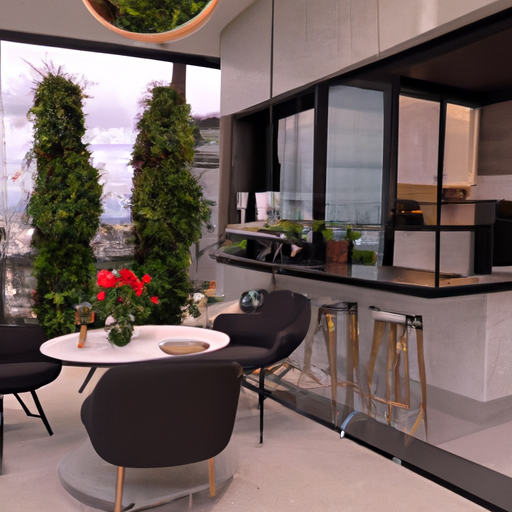Designing Open-Concept Spaces for Enhanced Family Interaction
Creating a home that is perfect for family living requires careful consideration of various architectural elements. One of the most important aspects to consider is designing open-concept spaces that enhance family interaction. Open-concept spaces are characterized by the absence of walls or barriers between different functional areas, such as the living room, dining room, and kitchen. This design approach not only creates a sense of spaciousness but also fosters a more cohesive and interactive family environment. In this article, we will discuss some key architectural considerations for designing open-concept spaces that are ideal for family living.
First and foremost, it is essential to determine the overall layout and flow of the open-concept space. This involves considering the placement of furniture, appliances, and other elements in a way that maximizes functionality and ease of movement. For instance, placing the kitchen island in the center of the space can serve as a focal point and a natural gathering spot for family members. Additionally, arranging seating areas around the island can encourage conversation and interaction during meal preparation and dining.
Another important consideration is the use of natural light and views to enhance the sense of openness and connection to the outdoors. Large windows, sliding glass doors, and skylights can help to bring in natural light and create a more inviting atmosphere. Moreover, positioning the open-concept space to take advantage of scenic views can further contribute to a sense of spaciousness and connection to nature. This can be particularly beneficial for families with young children, as it allows parents to keep an eye on their kids playing outside while still being able to engage in activities indoors.
Incorporating flexible and multi-functional elements into the design of the open-concept space can also help to accommodate the changing needs of a growing family. For example, a large dining table can double as a workspace for homework or crafts, while a cozy reading nook can be transformed into a play area for young children. Additionally, incorporating built-in storage solutions, such as cabinets and shelves, can help to keep the space organized and clutter-free, making it more conducive to family interaction.
One potential challenge of open-concept spaces is the lack of privacy and noise control. To address this issue, it is important to consider the use of architectural elements and materials that can help to create a sense of separation and sound absorption. For instance, installing sliding doors or movable partitions can provide a temporary barrier between different functional areas when needed. Similarly, incorporating soft furnishings, such as rugs and upholstered furniture, can help to absorb sound and create a more comfortable and quiet environment.
Finally, it is essential to consider the aesthetic aspects of the open-concept space, as this can greatly influence the overall atmosphere and mood of the home. Choosing a cohesive color palette and design style can help to create a sense of harmony and unity throughout the space. Additionally, incorporating personal touches, such as family photos and artwork, can help to make the space feel more welcoming and reflective of the family’s unique personality and tastes.
In conclusion, designing open-concept spaces for enhanced family interaction involves careful consideration of various architectural elements, including layout, natural light, flexibility, privacy, and aesthetics. By taking these factors into account, homeowners can create a home that is not only functional and spacious but also fosters a sense of togetherness and connection among family members.
Integrating Indoor-Outdoor Living Areas for a Balanced Family Lifestyle

Creating a home that is perfect for family living requires careful consideration of various architectural elements. One of the most important aspects to consider is the integration of indoor and outdoor living areas, which can significantly contribute to a balanced family lifestyle. This article will discuss the importance of integrating indoor and outdoor spaces, as well as provide some tips on how to achieve this in your home design.
Integrating indoor and outdoor living areas is essential for promoting a healthy and balanced lifestyle for your family. By creating a seamless flow between the two spaces, you can encourage your family members to spend more time outdoors, which has numerous health benefits, such as increased physical activity, reduced stress levels, and improved mental well-being. Furthermore, having a well-designed outdoor space can also provide an additional area for family bonding, relaxation, and entertainment.
To achieve a successful integration of indoor and outdoor living areas, it is crucial to consider the layout and design of your home. One of the most effective ways to create a seamless flow between the two spaces is by using large glass doors or sliding panels that can be easily opened to connect the indoor and outdoor areas. This not only allows for easy access between the two spaces but also helps to create a sense of continuity and spaciousness.
Another important aspect to consider is the placement of your outdoor living area. Ideally, it should be located adjacent to the main indoor living spaces, such as the living room, dining room, or kitchen. This will make it more convenient for family members to move between the indoor and outdoor areas and will also help to create a more cohesive and unified design.
In addition to the layout and design of your home, it is also essential to consider the materials and finishes used in both the indoor and outdoor spaces. Using similar or complementary materials and finishes can help to create a sense of continuity and harmony between the two areas. For example, you might choose to use the same flooring material both inside and outside, or you could select outdoor furniture and accessories that match the color scheme and style of your indoor living spaces.
Landscaping is another crucial element in integrating indoor and outdoor living areas. A well-designed garden or outdoor space can significantly enhance the overall aesthetic appeal of your home and create a more inviting and comfortable environment for your family. Consider incorporating elements such as patios, decks, or pergolas to create designated outdoor living spaces that can be used for various activities, such as dining, lounging, or playing.
Finally, it is essential to consider the practical aspects of integrating indoor and outdoor living areas. This includes ensuring that your outdoor space is easily accessible and safe for all family members, particularly young children and elderly relatives. You should also consider factors such as privacy, noise control, and maintenance when designing your outdoor living area.
In conclusion, integrating indoor and outdoor living areas is a crucial aspect of creating a home that is perfect for family living. By considering factors such as layout, design, materials, landscaping, and practicality, you can create a seamless and harmonious connection between the two spaces that will promote a healthy and balanced lifestyle for your family. With careful planning and attention to detail, you can transform your home into a haven for family living that is both functional and aesthetically pleasing.
Prioritizing Safety and Functionality in Home Design for Families
Creating a home that is perfect for family living requires careful consideration of various architectural elements. The design should prioritize safety and functionality to ensure that the living space is comfortable, practical, and secure for all family members. This article will discuss some key architectural considerations that can help you create a home that is ideal for family living.
One of the most important aspects of designing a family-friendly home is ensuring that it is safe for all occupants, particularly young children. This can be achieved by incorporating safety features such as rounded corners on countertops and furniture, non-slip flooring, and secure railings on stairs and balconies. Additionally, it is essential to consider the placement of electrical outlets, ensuring that they are out of reach of young children or equipped with safety covers. Windows should also be designed with safety in mind, featuring locks and possibly window guards to prevent accidental falls.
Functionality is another crucial factor in designing a home suitable for family living. The layout of the house should be practical and efficient, with ample storage space and designated areas for various activities. For instance, an open-plan living area can facilitate family interaction and communication, while a separate playroom or study can provide a quiet space for concentration and relaxation. The kitchen should be designed with functionality in mind, featuring ample counter space, storage, and easy access to appliances. Additionally, the inclusion of a mudroom or laundry room near the entrance can help keep the rest of the house clean and organized.
When designing a family-friendly home, it is essential to consider the needs of all family members, including those with mobility issues or disabilities. This may involve incorporating features such as wider doorways, ramps, and accessible bathrooms. Additionally, it is important to plan for future needs, as family dynamics and requirements may change over time. For example, a home office may need to be converted into a nursery, or an aging parent may require a ground-floor bedroom.
Another important consideration in creating a family-friendly home is the use of durable and low-maintenance materials. This can help reduce the time and effort required for cleaning and maintenance, allowing more time for family activities and relaxation. For instance, choosing flooring materials such as hardwood or tile can be more practical and easier to clean than carpet, particularly in high-traffic areas. Similarly, selecting countertops made from materials such as quartz or granite can provide a durable and low-maintenance surface for food preparation and dining.
Energy efficiency and sustainability should also be considered when designing a family-friendly home. Incorporating features such as energy-efficient appliances, insulation, and windows can help reduce energy consumption and utility bills, while also contributing to a more sustainable and environmentally friendly lifestyle. Additionally, the use of natural light and ventilation can help create a more comfortable and healthy living environment for the entire family.
In conclusion, designing a home that is perfect for family living involves careful consideration of various architectural elements, with a focus on safety and functionality. By incorporating features such as safety measures, practical layouts, and durable materials, you can create a living space that is comfortable, secure, and suitable for all family members. Additionally, considering the needs of all occupants and planning for future changes can help ensure that your home remains adaptable and functional for years to come. By prioritizing these factors in your home design, you can create a living environment that fosters family interaction, communication, and well-being.
Q&A
Question 1: What are the key architectural considerations when designing a family-friendly home?
Answer 1: The key architectural considerations when designing a family-friendly home include creating open and flexible living spaces, ensuring safety and accessibility, incorporating ample storage solutions, providing private and communal areas, and considering energy efficiency and sustainability.
Question 2: How can architects design homes that cater to the needs of both children and adults?
Answer 2: Architects can design homes that cater to the needs of both children and adults by incorporating adaptable spaces that can evolve with the family’s needs, providing separate areas for play and relaxation, ensuring safety features such as rounded corners and slip-resistant flooring, and creating a balance between open communal spaces and private retreats for individual family members.
Question 3: What are some architectural features that can enhance outdoor living for families?
Answer 3: Architectural features that can enhance outdoor living for families include covered patios or decks, outdoor kitchens, built-in seating areas, play structures or sports courts, and landscaping that provides both privacy and opportunities for exploration and play.
Conclusion
In conclusion, creating a home that is perfect for family living requires thoughtful architectural considerations. This involves prioritizing functionality, safety, and comfort while incorporating elements such as open floor plans, ample storage, and adaptable spaces. Additionally, integrating sustainable and energy-efficient features, as well as considering the home’s location and outdoor spaces, will contribute to a well-rounded family living environment. By carefully planning and designing with these factors in mind, a home can be tailored to meet the unique needs and preferences of each family, fostering a nurturing and enjoyable living space for all members.


